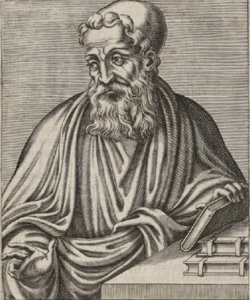Sinesios
Tampilan
 | |
| Nama dalam bahasa asli | (grc) Συνέσιος ὁ Κυρηναῖος |
|---|---|
| Biografi | |
| Kelahiran | 370 Kirene |
| Kematian | 413 Kirene |
| Uskup | |
| | |
| Kegiatan | |
| Spesialisasi | Filsafat |
| Pekerjaan | filsuf, penulis, Imam |
| Periode | Kekaisaran Romawi |
| Murid dari | Hypatia |
| Karya kreatif | |
Karya terkenal | |
Synesius (/sɪˈniːsiəs/; bahasa Yunani: Συνέσιος; s. 373 – s. 414) adalah seorang uskup Yunani dari Ptolemais di Libya kuno, sebuah bagian dari Pentapolis Barat Cyrenaica setelah 410. Ia lahir dari orang tua kaya di Balagrae (sekarang Bayda, Libya) dekat Cyrene antara 370 dan 375.[1] Ia diklaim merupakan keturunan raja-raja Sparta.[2]
Referensi
- ^
 Satu atau lebih kalimat sebelum ini menyertakan teks dari suatu terbitan yang sekarang berada pada ranah publik: Chisholm, Hugh, ed. (1911). "Synesius". Encyclopædia Britannica. 26 (edisi ke-11). Cambridge University Press. hlm. 294.
Satu atau lebih kalimat sebelum ini menyertakan teks dari suatu terbitan yang sekarang berada pada ranah publik: Chisholm, Hugh, ed. (1911). "Synesius". Encyclopædia Britannica. 26 (edisi ke-11). Cambridge University Press. hlm. 294.
- ^ National Library of Australia
Bacaan tambahan
- T.D. Barnes, "Synesius in Constantinople," Greek, Roman, and Byzantine Studies 27 (1986): 93-112.
- A.J. Bregman, Synesius of Cyrene, Philosopher-Bishop (Berkeley, 1982).
- A. Cameron and J. Long, Barbarians and Politics at the Court of Arcadius (Berkeley, 1993).
- A. de Francisco Heredero, "Bárbaros en la Cirenaica a través dela obra de Sinesio de Cirene" in: D. Álvarez Jiménez, R. Sanz Serrano and D. Hernández de la Fuente, El Espejismo del bárbaro: ciudadanos y extranjeros al final de la Antigüedad (Castellón, 2013) [1]
- A. de Francisco Heredero, "Synesios of Cyrene and the Defence of Cyrenaica" in: A. de Francisco, D. Hernández y S. Torres (eds.), New Perspectives on Late Antiquity in the Eastern Roman Empire (Cambridge, 2014) [2]
- Chr. Lacombrade, Synesios de Cyrène. Hellène et Chrétien (1951)
- J. H. W. G. Liebeschuetz, Barbarians and Bishops: Army, Church and State in the Age of Arcadius and Chrysostom (Oxford 1990).
- Konstantinos D.S. Paidas, He thematike ton byzantinon "katoptron hegemonos" tes proimes kai meses byzantines periodoy (398-1085). Symbole sten politike theoria ton Byzantinon (Athens, 2005).
- ib., 'Why Did Synesius Become Bishop of Ptolemais?', Byzantion 56 (1986): 180-195.
- D. Roques, Etudes sur la correspondance de Synesios de Cyrene (Brussels, 1989).
- T. Schmitt, Die Bekehrung des Synesios von Kyrene (2001).
- Hartwin Brandt, "Die Rede peri basileias des Synesios von Kyrene – ein ungewoehnlicher Fuerstenspiegel," in Francois Chausson et Etienne Wolff (edd.), Consuetudinis amor. Fragments d'histoire romaine (IIe-VIe siecles) offerts a Jean-Pierre Callu (0Roma: "L'Erma" di Bretschneider, 2003) (Saggi di storia antica, 19), 57-70.
- Ilinca Tanaseanu-Doebler, Konversion zur Philosophie in der Spaetantike. Kaiser Julian und Synesios von Kyrene (Stuttgart, Steiner, 2005) (Potsdamer altertumswissenschaftliche Beitraege, 23).
- Dimitar Y. Dimitrov, "Sinesius of Cyrene and the Christian Neoplatonism: Patterns of Religious and Cultural Symbiosis," in Mostafa El-Abbadi and Omnia Fathallah (eds), What Happened to the Ancient Library of Alexandria? (Leiden, Brill, 2008) (Library of the Written Word, 3).
- Synesius is portrayed in Ki Longfellow's Flow Down Like Silver, Hypatia of Alexandria[3] in a highly imaginative way.
- Heresy: the Life of Pelagius (2012) by David Lovejoy though fictional contains a portrait of Synesius based on his letters[1]
Pranala luar
Wikimedia Commons memiliki media mengenai Synesius.
Wikisumber memiliki naskah asli yang berkaitan dengan artikel ini:
Wikisumber memiliki naskah asli yang berkaitan dengan artikel ini:
 Karya tulis oleh atau tentang Sinesios di Wikisource
Karya tulis oleh atau tentang Sinesios di Wikisource- Synesius of Cyrene at livius.org (introduction by Jona Lendering and translations of all epistles, all speeches, all hymns, both homilies, all treatises)
- D. Roques, Études sur la correspondance de Synésios de Cyrène reviewed by John Vanderspoel, University of Calgary, in Bryn Mawr Classical Review 02.01.16 Diarsipkan 1999-04-27 di Wayback Machine.
- Cameron and Long reviewed by R.W. Burgess in BMCR Diarsipkan 2010-05-05 di Wayback Machine.
- Catholic Encyclopedia
